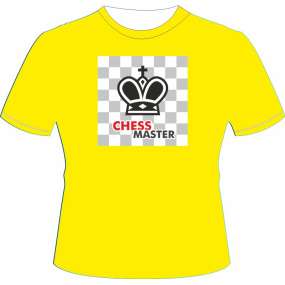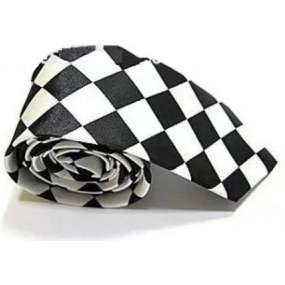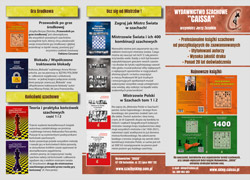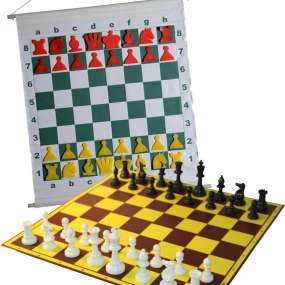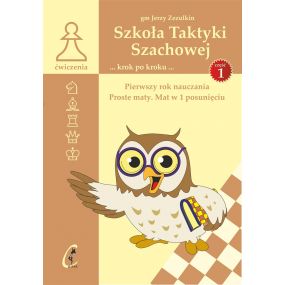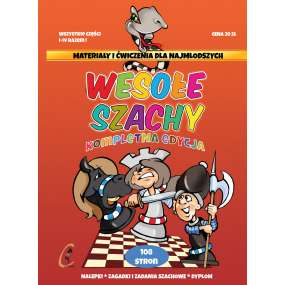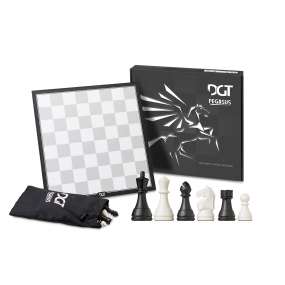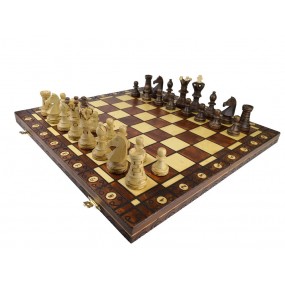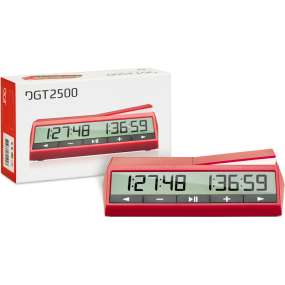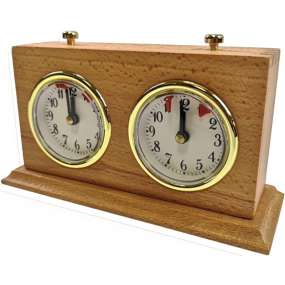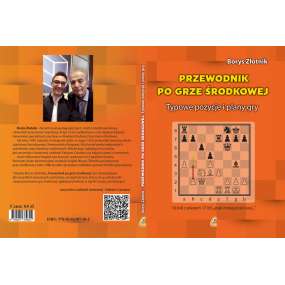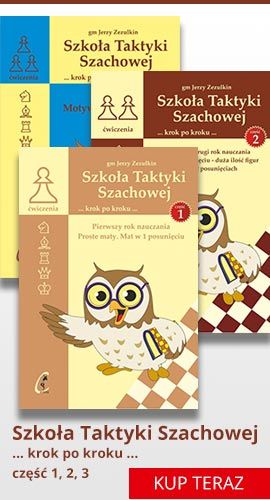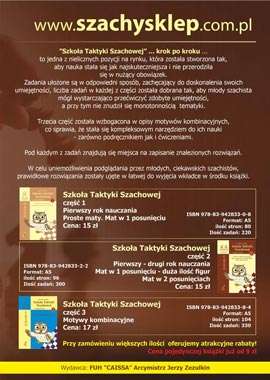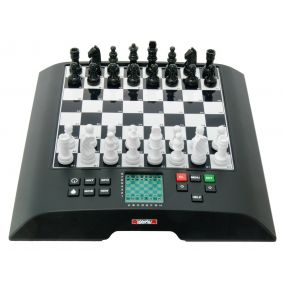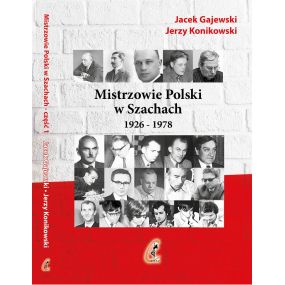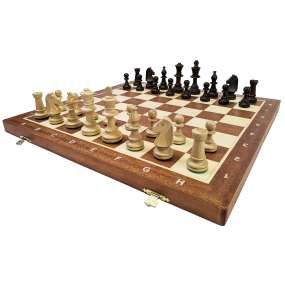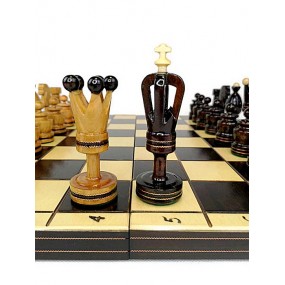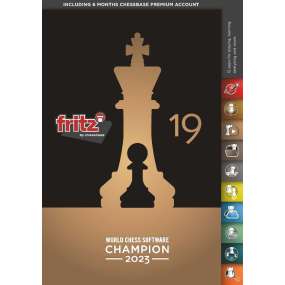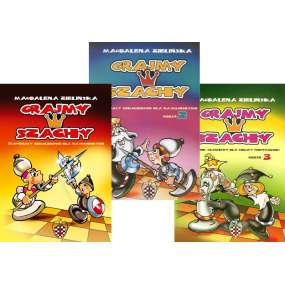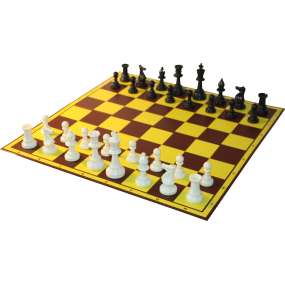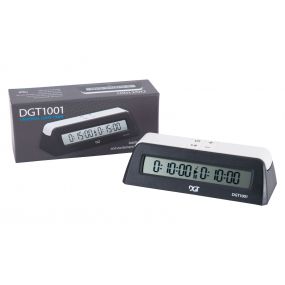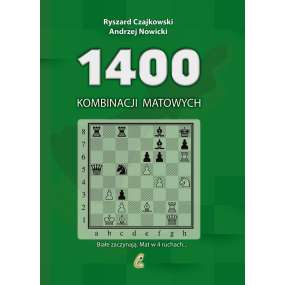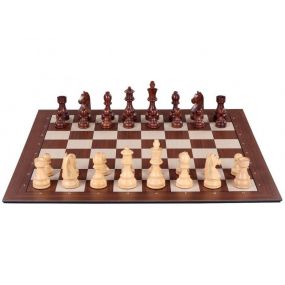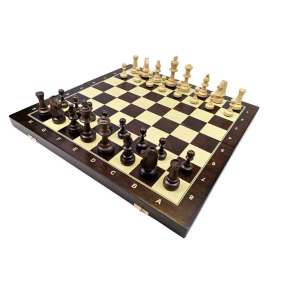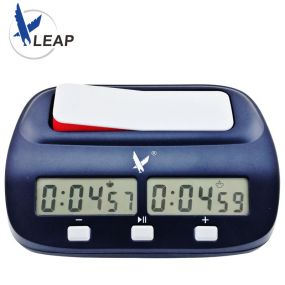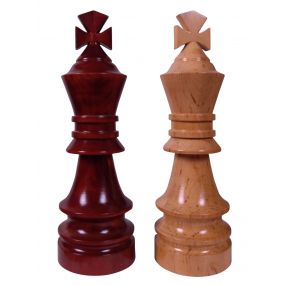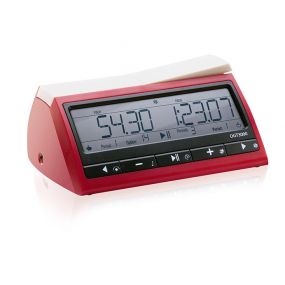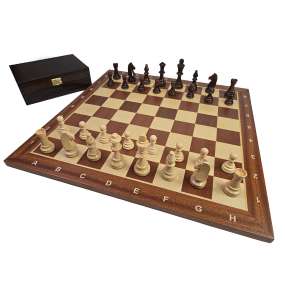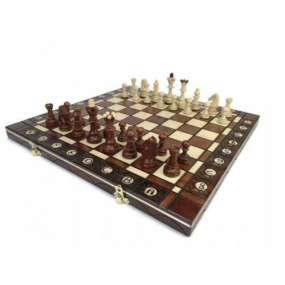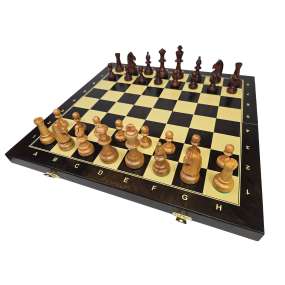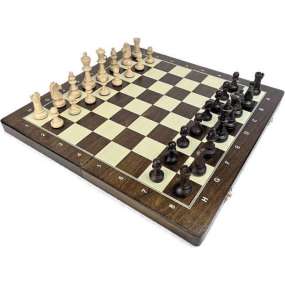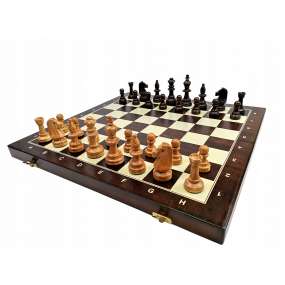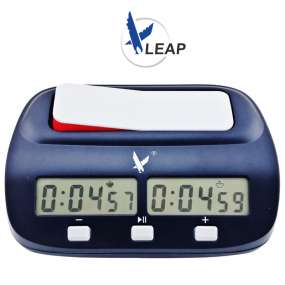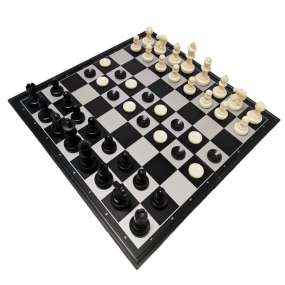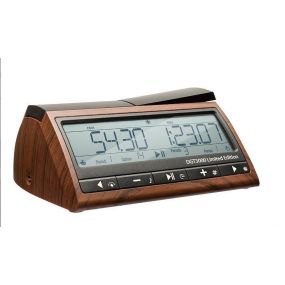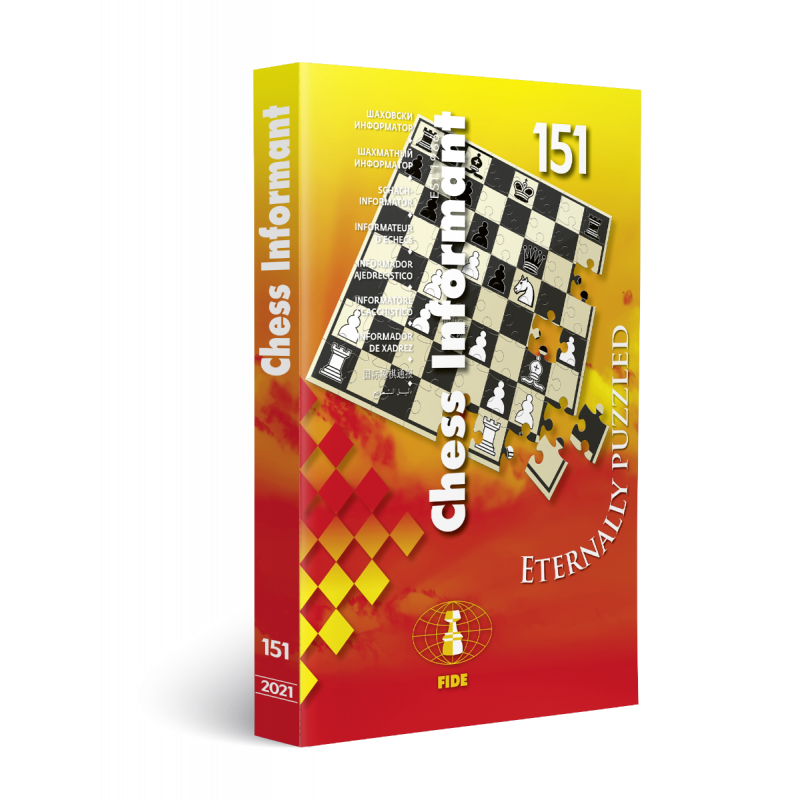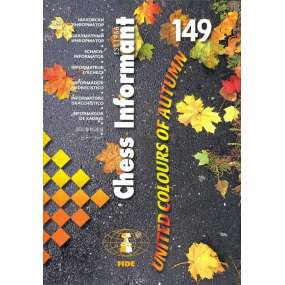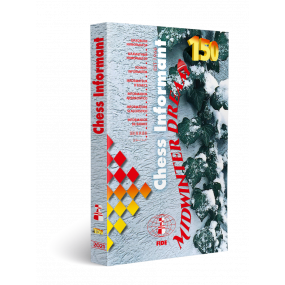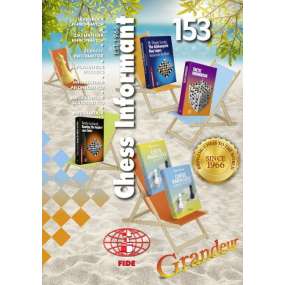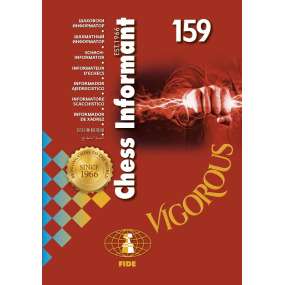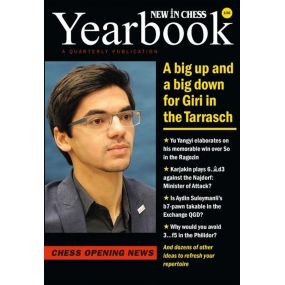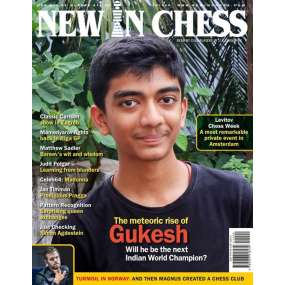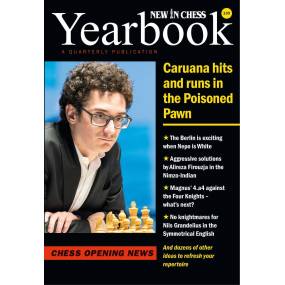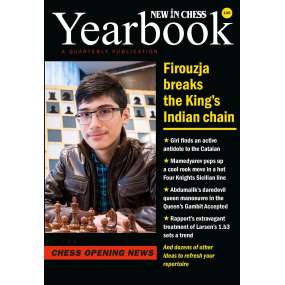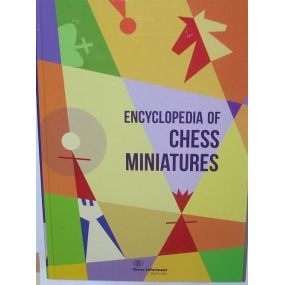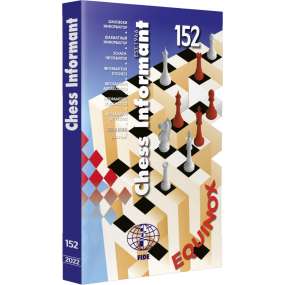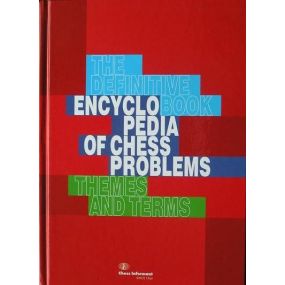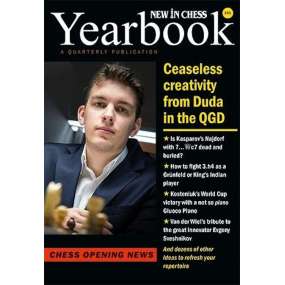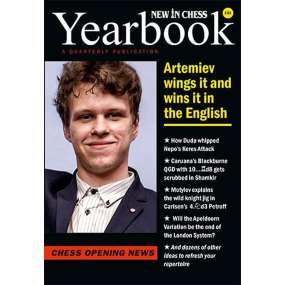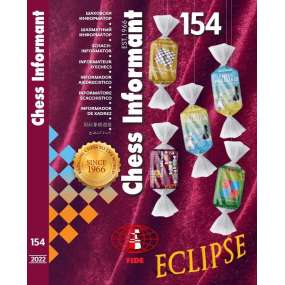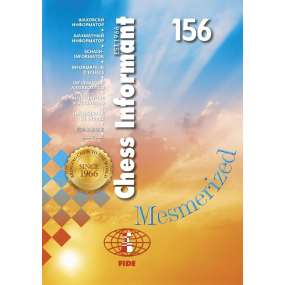Polecane
-
Mistrzowie Polski w Szachach Cz. 1 - 1926-1978 (K-5849)
0 Opinia(e)„Mistrzowie Polski w szachach” to oryginalna pozycja na rynku literatury szachowej dotyka bowiem tematyki nie do końca precyzyjnie opracowanej przez innych autorów, tj. naszych rodzimych, polskich szachistów.
54,00 zł Cena podstawowa 64,00 zł
-
Szachy turniejowe składane nr 5 mahoń intarsja (S-12)
0 Opinia(e)Szachy drewniane, składane ze specjalna kasetką na figury.
Figury turniejowe Staunton nr 5, obciążone, podklejane filcem.
Szachownica intarsjowana naturalny mahoń
Wymiar szachownicy: 47 x 47 x 2,5 cm;
Wymiar pola szachowego: 48 x 48 mm;
Wysokość króla: 93 mm; pionek: 4,5 cm;
Waga łączna: 2,00 kg;
257,00 zł Cena podstawowa 277,00 zł
-
Fritz 19 (P-0114)
0 Opinia(e)Nowy silnik Fritz 19 już dostępny!
Atakujący, tchórz, oszust lub czarodziej końcówek: Pokażę ci, jak wygrać z każdym! Po moich zwycięstwach w mistrzostwach świata w 2022 i 2023 roku, jestem panującym mistrzem świata oprogramowania szachowego i nie mogę się doczekać, aby pokazać ci, jak stać się jeszcze silniejszym przeciwko przeciwnikowi
357,00 zł Cena podstawowa 399,00 zł"Grajmy w szachy cz.1-3" Magdalena Zielińska ( K-3386/kpl)
0 Opinia(e)59,00 zł Cena podstawowa 74,00 zł
-
10 x ZESTAW SZKOLNY III: figury plastikowe Staunton nr 6 + szachownica tekturowa składana na pół (Z-16)
0 Opinia(e)PAKIET 10 ZESTAWÓW SZKOLNYCH - IDENTYCZNY ZESTAW DO TYCH UŻYWANYCH W PROJEKCIE "EDUKACJA PRZEZ SZACHY W SZKOLE"
477,00 zł Cena podstawowa 540,00 złWesołe szachy - Kompletna edycja ( K-3571/ke )
1 Opinia(e)Kompletna edycja książek z serii WESOŁE SZACHY wydana w jednym podręczniku.
Ten kompleksowy podręcznik dla najmłodszych szachistów zawiera nie tylko wszystkie 3 części "Wesołych Szachów, ale także część 4 - czyli całkowitą nowość, dotychczas nigdy nie wydaną!
39,00 zł
-
DGT 1001 czarny - Elektroniczny zegar szachowy dla szkół i klubów ( ZS-20/cz )
0 Opinia(e)Najnowszy zegar renomowanej holenderskiej firmy DGT!
Zegar idealny dla szkół i klubów szachowych!
Zegar DGT 1001 ma duży, przejrzysty wyświetlacz ( 11,5 x 2 cm), jest prosty w obsłudze i klasyczny w swoim wyglądzie.
Największą jego zaletą jest jednak cena - dużo niższa niż cena większości dostępnych na rynku zegarów.
Możliwość różnych ustawień oprócz tempa gry z dodawaniem czasu.
Wymiary: 15,5 x 6 x 4 cm
Zegar zasilany jedną bateria ( paluszek AA). Bateria w komplecie.
99,00 zł1400 kombinacji matowych - Ryszard Czajkowski, Andrzej Nowicki (K-6254)
0 Opinia(e)1400 Kombinacji matowych - Ryszard Czajkowski, Andrzej Nowicki
----------------------------------------------------------------------------
Niniejsza książka to unikalny zbiór 1400 diagramów z praktyki szachowej mistrzów i arcymistrzów z wielu krajów i różnych epok oraz własnych przykładów samych autorów.
Stopień trudności poszczególnych zadań jest na tyle zróżnicowany, by każdy szachista czerpał radość z ich rozwiązywania, niezależnie od swoich umiejętności. Tak więc w książce znajdziemy proste i bardziej skomplikowane przykłady taktyki szachowej, klasyczne końcówki, piękne kombinacje, które na zawsze przeszły do historii szachów, studia, etiudy i kompozycje szachowe oraz odzwierciedlenie zawartych w nich idei przeniesionych do praktyki turniejowej.
Czytelnik może poznać różnorodne sposoby matowania – od najprostszych jedno i dwuposunięciowych do mata w 262 (!!) posunięciach.
54,00 zł Cena podstawowa 59,00 zł
-
Zestaw SMART 1 do transmisji turniejowej:Szachownica elektroniczna DGT Smart + figury drewniane TIMELESS + zestaw kabli bocznych
0 Opinia(e)ZESTAW SMART 1 - zestaw do transmisji elektronicznej.
Zestaw stworzony z myślą o użytku profesjonalnym w ciągu szachownic (na turniejach, w klubach etc.)Zawiera:
- szachownicę elektroniczną DGT SMARTBOARD
- figury drewniane DGT TIMELESS
- zestaw połączeniowy (tzw. zestaw kabli bocznych)
2 077,00 zł Cena podstawowa 2 177,00 złSzachy Turniejowe nr 5 (48 cm) WENGE II (S-12/wenge/II)
0 Opinia(e)SZACHY TURNIEJOWE w kolorze WENGE NR. 5
Klasyczny, profesjonalny zestaw turniejowy w rozmiarze nr 5 (48x48 cm)
Ciemny kolor zestawu sprawia, że szachy prezentują się bardzo oryginalnie.215,00 zł Cena podstawowa 237,00 zł
-
LEAP KK9908 - Zegar szachowy, wszystkie tempa gry, atest FIDE (ZS-28)
0 Opinia(e) Nowy elektroniczny zegar szachowy LEAP KK9908
Nowy elektroniczny zegar szachowy LEAP KK9908Charakterystyka zegara:
• zegar z atestem FIDE!
• opcja dodawania czasu
• 37 ustawień zegara dla szachów oraz różnych gier
• maksymalna prostota obsługi
• duży, czytelny wyświetlacz pozwala na odczytanie czasu nawet z odległości 10m!waga: 0,2 kg
147,00 zł Cena podstawowa 157,00 złPuchar drewniany - Król (A-8)
0 Opinia(e)Puchary drewniane w kształcie figur szachowych w dwóch kolorach. Król, wysokość 35 cm, średnica podstawy 13 cm, wysokość podstawy 2,9 cm, waga: 0,7 kg
Puchary są idealne na nagrody dla dzieci w turniejach szachowych.
Podana cena dotyczy jednej sztuki.
Firma CAISSA jest producentem szachowych pucharów drewnianych.
Istnieje możliwość hurtowego zakupu niniejszych pucharów.
W sprawie zakupu hurtowego prosimy o kontakt mailowy: juzez@go2.pl lub telefoniczny: 509 983 593
70,00 zł
-
DGT 3000 - Elektroniczny zegar szachowy FIDE (ZS-25) 5 LAT GWARANCJI
0 Opinia(e)Zegar elektroniczny (Holandia), następca (ulepszona wersja) zegara DGT XL.
Po światowym sukcesie cyfrowego zegara DGT XL, prezentujemy DGT 3000 model FIDE.
270,00 złProfesjonalny Zestaw Szachowy - Drewniany 55 x 55 cm (Z-4/C)
0 Opinia(e)Figury szachowe STAUNTON 6 w kasetce drewnianej + deska drewniana nr6
Figury szachowe turniejowe, drewniane, obciążane, podklejane filcem, wkładane do kasetki drewnianej
Wysokość króla 98mmm.
Deska drewniana, intarsjowana
Wymiary: 55x55x2cm
Wymiary pola: 56 x 56 mm
Waga łączna 4,00 kg
277,00 zł
-
Szachy Senator (S-15)
0 Opinia(e)Szachownica i figury wykonane są z drewna.
Wymiary: 420 x 210 x 50 mmKról: 78 mm
Waga 1.60 kg
177,00 zł Cena podstawowa 197,00 złSzachy Turniejowe Wiśniowe 48x48cm (S-12/wi)
0 Opinia(e)SZACHY TURNIEJOWE NR 5 - Wiśniowe
Drewniane figury Staunton nr 5 z drewna wiśniowego - obciążone, podklejone zielonym filcem
- Wysokość króla - ok. 90 mm;
- Wysokość pionka - ok. 45 mm
Szachownica drewniana, składana na pół z miejscem na figury w środku.
- Wymiar szachownicy: 48 x 48 x 2,7 cm;
- Wymiar pola szachowego: 48 x 48 mm;
Waga łączna: 1.7 kg;
285,30 zł Cena podstawowa 317,00 zł
-
Szachy drewniane TURNIEJOWE 40x40 cm (S-11/ż)
0 Opinia(e)Szachy drewniane turniejowe w rozmiarze idealnie dopasowanym do dzieci w wieku 6-10 lat !!
Figury szachowe - drewniane, wykonane w klasycznym kształcie.
Zastosowany rozmiar figur to idealne rozwiązanie dla dzieci, które zaczynają swoją przygodę z królewską grą.
Szachownica - klasyczna składana na pół szachownica w formie zamykanej kasetki, wewnątrz której znajdziemy miejsce na figury.
Dzięki temu, że szachownica jest składana i można w niej przechowywać figury, zestaw jest prosty w użyciu i transporcie.
Szachy idealnie sprawdzą się jako narzędzie treningowe, które można mieć właściwie zawsze przy sobie.
Drewno: Grab, Buk, Akacja
Waga zestawu: ok.1 kg
WYPRODUKOWANE W POLSCE!
157,00 zł Cena podstawowa 177,00 złSzachy Turniejowe Czereśniowe 48x48cm (S-12/CZ)
0 Opinia(e)SZACHY TURNIEJOWE NR 5 - CZEREŚNIOWE
Drewniane figury Staunton nr 5 z drewna czereśniowego - obciążone, podklejone zielonym filcem
- Wysokość króla - ok. 90 mm;
- Wysokość pionka - ok. 45 mm
Szachownica drewniana, składana na pół z miejscem na figury w środku.
- Wymiar szachownicy: 48 x 48 x 2,7 cm;
- Wymiar pola szachowego: 48 x 48 mm;
Waga łączna: 1.7 kg;
237,60 zł Cena podstawowa 297,00 zł
-
Plecak z motywem szachowym (A-129)
0 Opinia(e)Piękny, nowoczesny plecak w uniwersalnym - szarym kolorze z motywem figur szachowych.
Idealny na zajęcia szkolne, krótkie wyjazdy lub treningi, ale także jako codzienny element garderoby.84,15 zł Cena podstawowa 99,00 zł10x LEAP KK9908 - Zegar szachowy, wszystkie tempa gry, atest FIDE (ZS-28/10)
0 Opinia(e) Nowy elektroniczny zegar szachowy LEAP KK9908
Nowy elektroniczny zegar szachowy LEAP KK9908Charakterystyka zegara:
• zegar z atestem FIDE!
• opcja dodawania czasu
• 37 ustawień zegara dla szachów oraz różnych gier
• maksymalna prostota obsługi
• duży, czytelny wyświetlacz pozwala na odczytanie czasu nawet z odległości 10m!waga: 0,2 kg
1 440,00 zł Cena podstawowa 1 570,00 zł
-
Składany zestaw magnetyczny 2 w 1: SZACHY + WARCABY 35 cm (S-233)
0 Opinia(e)Świetny, podróżny, składany zestaw dwóch gier: SZACHY i WARCABY w wersji magnetycznej!
Uwaga: bierki warcabowe nie są magnetyczne.
65,45 zł Cena podstawowa 77,00 złDGT 3000 LIMITOWANA EDYCJA FIDE - 5 lat gwarancji (ZS-30)
0 Opinia(e)Edycja LIMITOWANA jednego z najlepszych elektronicznych zegarów szachowych DGT 3000 została wydana z okazji 25-lecia firmy DGT.
Od wersji standardowej zegara różni go ekskluzywny wygląd - wygląda jak by był wykonany z drewna!
Pozostałe parametry nie zostały zmienione.
270,00 zł Cena podstawowa 295,00 zł
INFORMATOR nr 151 (K-353/151)
151 wydanie Chess Informant.
Eternally Puzzled

Gwarancja zwrotu pieniędzy

Bezpieczne i szybkie dostawy

Bezpieczeństwo transakcji dzięki certyfikatowi SSL
Presents 350 pages of the very best in chess:
Sokolov – Tata Steel 2022 Wijk aan Zee (Tournament Review)
Moradiabadi – Fide Grand Prix I Berlin (Tournament Review)
Leitao – The Clash of Generations (Tournament Review)
Ivanisevic – Zugzwang – Modern Practice (Instructive Lesson)
Prusikin – Bishop Pair in Closed Positions (Instructive Lesson)
Foisor – IQP Positions – Ideas and Plans for White (Instructive Lesson)
Golubev – The Berlin Ruy Lopez Re1 Variation (Theoretical Survey)
Davies – The 3…Qd6 Scandinavian (Theoretical Survey)
Perunovic – The Paulsen Sicilian (Theoretical Survey)
Szabo – Fianchetto English A49 – part II (Theoretical Survey)
Petrov – World Championship Game Changers – part 3
Rogers – Manila Chess Olympiad 1992 (Roger’s Reminiscences)
Griffin – A Tribute to Lev Psakhis (From Informant Archives)
Traditional sections: games, combinations, endings, Tournament reviews, the best game from the preceding volume and the most important theoretical novelty from the preceding volume.
The periodical that pros use with pleasure is at the same time a must have publication for all serious chess students!
Przejrzeć
Powiązany produkt
INFORMATOR nr 149 (K-353/149)
CHESS INFORMANT’S 149 th ADVENTURE
United Colours of Autumn
Presents 350 pages of the very best in chess:
Duda - How I won the World Cup
Ivic & Mio. Perunovic - World Cup Fairy Tale
Leitao - South Americans in the World Cup
Perunovic - Duda’s World Cup Black Repertory
Foisor - St. Louis Rapid&Blitz (Tournament review)
Moradiabadi - Sinquefield Cup (Tournament review)
Gormally - Danny’s Chess Diary (Northumbria Masters)
Priyadharshan K. - Asian Masters - Meltwater Tour (Tournament review)
Davies - Understanding the Openings (The Semi-Tarrasch part 1)
Szabo - Anti-Marshall 8.a4 d5!? (Opening Survey)
Prusikin - A Story about Horses and Elephants (Knight versus Bishop)
Petrov - World Championship Game Changers - part 1
Rogers - Reggie Emilia 1984/1985 (Rogers’ Reminiscences)
Griffin - A Tribute to Iron Tigran (Polugaevsky-Petrosian 1970.)
Traditional sections: games, combinations, endings, Tournament reviews, the best game from the preceding volume and the most important theoretical novelty from the preceding volume.
The periodical that pros use with pleasure is at the same time a must have publication for all serious chess students!
16 produkt(ów) w tej kategorii
INFORMATOR nr 153 Grandeur (K-353/153)
Czasopismo, z którego chętnie korzystają profesjonaliści, jest jednocześnie publikacją obowiązkową dla wszystkich poważnych adeptów szachów!
Wydanie nr 153 - Grandeur
Produkt sprowadzany na zamówienie: sklep@caissa.pl
INFORMATOR nr 159 (K-353/159)
Presents 350 pages of the very best in chess:
- AFEK – WIJK AAN ZEE 2024
- LEITAO – THE DIFFICULT ART OF DEFENCE IN CHESS
- GORMALLY – DANNY'S CHESS DIARY – MY HASTINGS NIGHTMARE
- KOTRONIAS – KING'S INDIAN DEFENCE – GLIGORIC SYSTEM
- PERELSHTEYN – THE ALEKHINE – EXCHANGE VARIATION
- DAVIES – UNDFERSTANDING THE OPENINGS
- PERUNOVIC – THE SICILIAN OFF-ROAD
- MARIN – OLD WINE IN NEW BOTTLES
- PRUSIKIN – THE CARO-KANN EXCHANGE VARIATION
- BARAK GONEN – WORLD OF CORRESPONDENCE CHESS
- ROGERS – ASIAN TEAM CHAMPIONSHIP – Europe v Asia Match, Batumi 2001
- GRIFFIN – FROM THE CHESS INFORMANT ARCHIVES
Traditional sections: 263 games and fragments, combinations, endings, Tournament reviews, the best game and the most important theoretical novelty from the preceding volume.
The periodical that pros use with pleasure is at the same time a must have publication for all serious chess students!
NEW IN CHESS - Yearbook nr 136 (K-339/136)
New In Chess Yearbook, which appears four times a year, contains the latest news in chess openings. Each issue brings you dozens of new ideas on the cutting edge of modern chess opening theory. Have a look at what this issue has to offer.
New In Chess 2019/6: The Club Player's Magazine (C-016)
New in Chess Yearbook 139 (K-339/139)
New In Chess Yearbook, which appears four times a year, contains the latest news in chess openings. Each issue brings you dozens of new ideas on the cutting edge of modern chess opening theory. Have a look at what this issue has to offer.
Forum
This issue’s Forum Section features an article by René Olthof on the stunning piece sacrifice with which Fabiano Caruana took Maxime Vachier-Lagrave by surprise in the second leg of the Candidates Tournament. This is followed by some unique analysis material by Ganguly on a game he lost against Pavel Eljanov! Two other grandmasters, Mikheil Mchedlishvili and Max Warmerdam, also made a contribution, and you should certainly check out IJntze Hoekstra’s short but intriguing note to the book Side-Stepping Mainline Theory by Gerard Welling and Steve Giddins!
From Our Own Correspondent
Our GM correspondent Erwin l’Ami starts his column with a good equalizing method for Black in the Tarrasch and then presents a thorough analysis of a correspondence game with the Delayed Poisoned Pawn in the Najdorf. L’Ami has played the Black side of Kramnik’s QGD endgame and demonstrates that Black is OK here – which cannot be said of his two final subjects, the Poisoned Pawn line in the London System and the Winawer French with 7…0-0.
Reviews
Part of Glenn Flear’s Reviews column is dedicated to modern media again. The 2-volume ebook The Modern French by Kryakvin is reviewed and compared to two other recent works on the French: Anish Giri’s awesome Lifetime repertoire course; The French Defense (for Chessable) and Pentala Harikrishna’s book Beat the French Defence with 3.Nc3. The Englishman also pays attention to Ilya Smirin’s book Sicilian Warfare – arguably more than just an opening book – and of course the latest masterpiece by Parimarjan Negi: Grandmaster repertoire: 1.e4 vs Minor Defences.
New in Chess Yearbook 140 (K-339/140)
New In Chess Yearbook, which appears four times a year, contains the latest news in chess openings. Each issue brings you dozens of new ideas on the cutting edge of modern chess opening theory. Have a look at what this issue has to offer.
Forum
French guru Viktor Moskalenko shows two recent OTB games in the Forum Section, in which he was successful with some great ideas he presented in his latest book The Fully-Fledged French. One is a piece sac that gained him a 13-move win with black! Bogdan Lalic takes a look at another surprising black piece sac, in the King’s Indian this time. The Forum also contains some novelties from the World Cup, presented by Luis Rodi, Peter Boel and Frank Erwich.
From Sadler’s Engine Room
Matthew Sadler is our new columnist! He will alternate with Erwin l’Ami’s ‘From Our Own Correspondent’ column. The English grandmaster is well-known for the best-seller Game Changer he wrote with Natasha Regan, about computer chess. His new column will be on opening treatment by the top engines, and in his first instalment Matthew shows that these beasts are not at all averse to some offbeat opening play!
Reviews
Four books are reviewed this time – all of them with a quite original angle. The Modernized Italian Game for White by Alexander Kalinin & Nikolai Kalinichenko is more about understanding than learning lines by heart, and we know that it’s the same with Viktor Moskalenko’s books. With The Fully-Fledged French, the Ukrainian grandmaster has produced a new shoot on his favourite French opening, with a lot of brand new ideas. The didactic approach of Thomas Willemze in The Scandinavian for Club Players is really something else, and of course we couldn’t ignore the Iron English by the creative English duo Simon Williams & Richard Palliser.
GM Tadic B., IM Arsovic G. " Encyklopedia miniatur szachowych" ( K-3550/chm )
BRAK NA MAGAZYNIE - produkt może zostać sprowadzony "NA ZAMÓWIENIE"
New in Chess Yearbook 141 (K-339/141)
New In Chess Yearbook, which appears four times a year, contains the latest news in chess openings. Each issue brings you dozens of new ideas on the cutting edge of modern chess opening theory. Have a look at what this issue has to offer.
INFORMATOR nr 154 (K-353/154)
Presents 350 pages of the very best in chess:
Leitao – Opening Trends in South American Chess
Moradiabadi – European Club Cup (Tournament Review)
Navara – European Club Cup – Novy Bor
Shyam Sundar – This or That? – Part 2
Gormally – 4NCL and Crypto Blitz (Tournament Review)
Marin – Benoni Files (Old Wine in New Bottles)
Kotronias – King’s Indian – Fianchetto Variation (Survey)
Perelshteyn – Dzindzi-Indian (Theoretical Survey)
Davies – The 3…g6 Ruy Lopez – Part 2 (Theoretical Survey)
Perunovic – Catalan (Theoretical Survey)
Rogers – Toluca 1982 Interzonal (Roger’s Reminiscences)
Griffin – Karpov – Timman 1981(From Informant Archives)
Traditional sections: games, combinations, endings, Tournament reviews, the best game from the preceding volume and the most important theoretical novelty from the preceding volume.
The periodical that pros use with pleasure is at the same time a must have publication for all serious chess students!
INFORMATOR nr 156 (K-353/156)
Presents 350 pages of the very best in chess:
- Gormally – World Chess Championship – Nepo – Ding (Review)
- Shyam Sundar – World Chess Championship – The Most Instructive Moments and Positions
- Miodrag & Milos Perunovic – European Chess Championship (Tournament Report)
- Leitao – The English Opening (WCH Edition – Theoretical Survey)
- Foisor – Woman’s Candidates Final (Instructive Review)
- Prusikin – The Power of Knight Pair(Instructive Lesson)
- Davies – The Maroczy Bind (Theoretical Survey)
- Kotronias – The King’s Indian Saemisch (Theoretical Survey)
- Perelshteyn – The Alekhine Defence (Theoretical Survey)
- Rogers – Telechess Olympiads (Roger’s Reminiscences)
- Griffin – Vaganian – Gulko, Baku 1977 (From Informant Archives)
- Barak Gonen – Correspondence Chess (Review)
Traditional sections: games, combinations, endings, Tournament reviews, the best game from the preceding volume and the most important theoretical novelty from the preceding volume.
The periodical that pros use with pleasure is at the same time a must have publication for all serious chess students!



